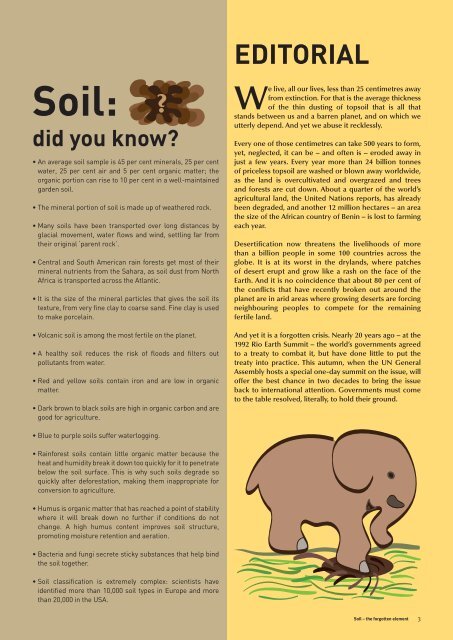Tunza Vol. 9.2: Soil - the forgotten element - UNEP
Tunza Vol. 9.2: Soil - the forgotten element - UNEP
Tunza Vol. 9.2: Soil - the forgotten element - UNEP
Create successful ePaper yourself
Turn your PDF publications into a flip-book with our unique Google optimized e-Paper software.
<strong>Soil</strong>:<br />
did you know?<br />
• An average soil sample is 45 per cent minerals, 25 per cent<br />
water, 25 per cent air and 5 per cent organic matter; <strong>the</strong><br />
organic portion can rise to 10 per cent in a well-maintained<br />
garden soil.<br />
• The mineral portion of soil is made up of wea<strong>the</strong>red rock.<br />
• Many soils have been transported over long distances by<br />
glacial movement, water flows and wind, settling far from<br />
<strong>the</strong>ir original ‘parent rock’.<br />
• Central and South American rain forests get most of <strong>the</strong>ir<br />
mineral nutrients from <strong>the</strong> Sahara, as soil dust from North<br />
Africa is transported across <strong>the</strong> Atlantic.<br />
• It is <strong>the</strong> size of <strong>the</strong> mineral particles that gives <strong>the</strong> soil its<br />
texture, from very fine clay to coarse sand. Fine clay is used<br />
to make porcelain.<br />
• <strong>Vol</strong>canic soil is among <strong>the</strong> most fertile on <strong>the</strong> planet.<br />
• A healthy soil reduces <strong>the</strong> risk of floods and filters out<br />
pollutants from water.<br />
• Red and yellow soils contain iron and are low in organic<br />
matter.<br />
• Dark brown to black soils are high in organic carbon and are<br />
good for agriculture.<br />
EDITORIAL<br />
We live, all our lives, less than 25 centimetres away<br />
from extinction. For that is <strong>the</strong> average thickness<br />
of <strong>the</strong> thin dusting of topsoil that is all that<br />
stands between us and a barren planet, and on which we<br />
utterly depend. And yet we abuse it recklessly.<br />
Every one of those centimetres can take 500 years to form,<br />
yet, neglected, it can be – and often is – eroded away in<br />
just a few years. Every year more than 24 billion tonnes<br />
of priceless topsoil are washed or blown away worldwide,<br />
as <strong>the</strong> land is overcultivated and overgrazed and trees<br />
and forests are cut down. About a quarter of <strong>the</strong> world’s<br />
agricultural land, <strong>the</strong> United Nations reports, has already<br />
been degraded, and ano<strong>the</strong>r 12 million hectares – an area<br />
<strong>the</strong> size of <strong>the</strong> African country of Benin – is lost to farming<br />
each year.<br />
Desertification now threatens <strong>the</strong> livelihoods of more<br />
than a billion people in some 100 countries across <strong>the</strong><br />
globe. It is at its worst in <strong>the</strong> drylands, where patches<br />
of desert erupt and grow like a rash on <strong>the</strong> face of <strong>the</strong><br />
Earth. And it is no coincidence that about 80 per cent of<br />
<strong>the</strong> conflicts that have recently broken out around <strong>the</strong><br />
planet are in arid areas where growing deserts are forcing<br />
neighbouring peoples to compete for <strong>the</strong> remaining<br />
fertile land.<br />
And yet it is a <strong>forgotten</strong> crisis. Nearly 20 years ago – at <strong>the</strong><br />
1992 Rio Earth Summit – <strong>the</strong> world’s governments agreed<br />
to a treaty to combat it, but have done little to put <strong>the</strong><br />
treaty into practice. This autumn, when <strong>the</strong> UN General<br />
Assembly hosts a special one-day summit on <strong>the</strong> issue, will<br />
offer <strong>the</strong> best chance in two decades to bring <strong>the</strong> issue<br />
back to international attention. Governments must come<br />
to <strong>the</strong> table resolved, literally, to hold <strong>the</strong>ir ground.<br />
• Blue to purple soils suffer waterlogging.<br />
• Rainforest soils contain little organic matter because <strong>the</strong><br />
heat and humidity break it down too quickly for it to penetrate<br />
below <strong>the</strong> soil surface. This is why such soils degrade so<br />
quickly after deforestation, making <strong>the</strong>m inappropriate for<br />
conversion to agriculture.<br />
• Humus is organic matter that has reached a point of stability<br />
where it will break down no fur<strong>the</strong>r if conditions do not<br />
change. A high humus content improves soil structure,<br />
promoting moisture retention and aeration.<br />
• Bacteria and fungi secrete sticky substances that help bind<br />
<strong>the</strong> soil toge<strong>the</strong>r.<br />
• <strong>Soil</strong> classification is extremely complex: scientists have<br />
identified more than 10,000 soil types in Europe and more<br />
than 20,000 in <strong>the</strong> USA.<br />
<strong>Soil</strong> – <strong>the</strong> <strong>forgotten</strong> <strong>element</strong><br />
3
















